
It's a bit of a stretch of the imagination to believe that this actually happened, but information from court rolls indicate that Jeanne did, in fact, claim this to be entirely true. There is no mention of the time period that this was spread out over, or whether it occurred in the span of one busy evening.
Personally, four hundred and forty-four times seems like a lot before deciding that the perpetrator was not a rather good-looking human, but a demon instead.
As always, there's more where that came from in the Very Secret Sex Lives of Medieval Women by Yours Truly, and it's available where-ever books are sold, online through Mango Publishing or your preferred book vendor or have your bricks-and-mortar shop order it in for you.
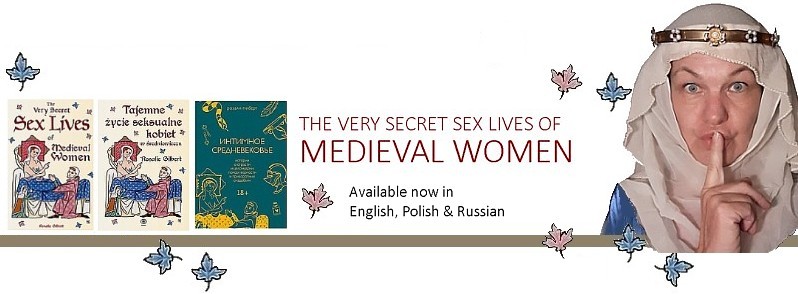
Dust me off!
21 November 2022 11:53 pm
Look, I know we are all sick of hearing about it, but by now we all understand the challenges I've faced with publishing and the front cover of my book. This week I had dealings with a venue which was hoping to sell my book over the course of a medieval event, but, in an exceptionally tactless way, informed me that they felt the cover was (and I quote) "A bit on the nose" and that it wasn't suitable for a family-friendly festival in their gift shop.
I completely understand that the original cover screams SEX in large, unwieldy letters, which is one of the reasons I printed a dust jacket. That and the nipple censorship thing, of course.
The venue was not particularly happy with the dust jacket either, so with an extremely limited time frame, I got this one off to the printer for a new dust jacket. The venue conceded that this one was (and again, I quote) "A bit better." They insist that the book be wrapped somehow so it can't be perused by potential customers. I really would have just given it all a solid miss for the way they feel, except for the fact that they are actually potentially interested in stocking my book all year round.
Anyway, I'm now waiting for these to arrive, so I can trim them and wrap the books with their new "bit better, less on the nose" jackets.


Mango Publishing in the USA would like to let you know that they are 30% off site-wide, including my book! Have you got your Secret Santa pressie yet?
No? Well then!
Kitchen things
2 September 2022 02:15 pm
I have to admit, when I was setting up for the Trotula Hair Powder, I was extremely grateful that I'd been hoarding little ceramic bowls in case I needed them for re-enacting. I really wish that I'd taken this photo without the cutting board underneath. The contrast of the grey timber of the old wood table is much nicer for photos.
Drat.
Trotula's Hair Powder
30 August 2022 11:24 pm
Making a medieval hair powder using the recipe attributed to Trotula in On Cosmetics.
The Trotula, or the set of three texts attributed to Trotula, included a section called On Women's Cosmetics, and includes recipes for beauty. Among these, we find a hair powder, so that the hair remains sweetly scented. In the section about On Various Kinds of Adornments, it reads:

But when she combs her hair, let her have this powder.Take some dried roses, clove, nutmeg, watercress and galangal. Let all these, powdered, be mixed with rose water.With this water let her sprinkle her hair and comb it with a comb dipped in this same water so that [her hair] will smell better.And let her make furrows in her hair and sprinkle on the above-mentioned powder, and it will smell marvelously.
I have recreated this powder and the scented rosewater to use in my MEDIEVAL BATH DISPLAY and have included a step by step guide to my approach, including my expectations and how it really worked out.
The overall verdict? An absolute delight and one recipe where Trotula really comes through.
The expectation:
There were a number of things to think about before I started.
- Drying the ingredients or buying them pre-powdered?
- Can I buy galangal and watercress locally?
- Air dry or oven dry the grown ingredients?
- Watercress doesn't smell like anything in particular, so what does it bring to the mix?
- Which roses should I use?
- When I add the rosewater to the powder, do I need to let it dry again and re-powder it?
- How much of the powder do I add to the rosewater for the combing water so it isn't gluggy?
- How much of which ingredients should I use?
- Will it actually make any real difference to actual hair?
- How long will it last as a hair powder?
- Do any of the spices and plants have benefits associated with them which makes them particularly useful for a hair powder other than that they smell nice?
The reality:
This was a journey of great discovery, where I discovered:
- Less is more of some things.
- Watercress has quite a sweet smell when dried.
- Air-dried roses take forever and don't crumble well.
- Watercress plants can be bought from supermarkets!
- Galangal is available at all good Indian spice stores.

What you need:
Ingredients
Roses
Galangal
Watercress
Cloves
Nutmeg
Rosewater
Kitchen things
Spoon
Bowl for mixing
Jug for rosewater
Mortar and pestle for powdering
Method:
My plan was to buy what I could already prepared, and dry the other herbs myself without the use of modern ovens or drying implements. I felt that this would give me (perhaps) a more honest attempt at what might be achieved by a medieval woman at home. That said, I did buy the rosewater already made and several of the spices pre-ground. Mostly the reason for this was because I was genuinely unsure what quantities I would need to achieve a goodly amount of ground spices to use.
I checked some of the properties attributed to the plants being used in the hair powder to see if they were chosen for beneficial reasons, and was interested to note that Hildegarde von Bingen pairs nutmeg with galingale (galangal) to cure palsy of the brain and nutmeg itself against bitterness of the heart. Roses, we already know, are tied to the emotion, love.

Roses
I bought regular roses from the supermarket and air dried them in a bunch in my kitchen. This was a terrible idea, as the rose heads took a really long time to dry. I had some in the cupboard which were quite old, but they still didn't powder well. For future rose powder, I would separate the petals and dry them on a tray in a really hot sun. These petals had some smell but like many modern roses, not a great deal, so for my next powder, I will use especially scented roses. I started with one spoon, but ended up adding a second one.

Watercress
After finding it powdered online expensively with added shipping, I was surprised to find it fresh at the supermarket. It smelled like wet plant when a few leaves were crushed but after drying, had a sweet meadow smell which was very nice. I dried this by blotting the excess moisture with paper towels and sun drying over several days. I would spread it thinner on the tray for drying next time. Initially, I used one spoon for the mix, but later added a second one.

Galangal (Galingale)
I bought this from an Indian Spice store but was able to find it afterwards in supermarkets.
I will be planting in my garden for future fresh root but this was an easy option for me this time.
It has a gingery smell which was very nice, and I used one spoon full.

Cloves
I bought this already powdered simply because I couldn't get hold of any whole ones at the moment, which was odd because it's usually very easy to get.
The smell is quite strong, and I expected it to overpower everything else if I used an equal amount, but it was tempered by the other ingredients.
Hildegarde recommends cloves to clear stuffiness of the head, although whether Trotula chose it to include for that reason, I do not know.

Nutmeg
I bought powdered nutmeg although I already had some in my cupboard because I wanted fresh. I expected the nutmeg to make the entire powder reminiscent of baked cookies so I felt it was a good inclusion. Because I needed a starting point, I used a single spoon full for the powder, and it seemed to work well at that level.
Rosewater
I was honestly going to have a go at making some but on discovering four different brands of it at cheap prices, I piked out and bought some.
I feel that even without the addition of any of the powder, it would be successful as a hair perfume by itself. Whether or not the spices would ruin it or mix well with it was to be seen.
Method:
The roses and the watercress were not completely dry enough to get a fine powder in the quantity I needed, so in order to make a start, I fine chopped the rose petals and gave the watercress a really thorough crushing with my hands.
I used a single spoon of each of the dry ingredients as a starting point expecting the cloves to completely overpower everything else in the mix and was very surprised to find that not only was the mix extremely nice on a one-to-one basis, it was also quite strong, meaning a little would go a long way. This is particularly good as the price of spices in the middle ages was likely to be expensive depending on where one lived. It wasn't going to be cheap and some of the plants were unlikely to have been locally grown.
I then added a heaped teaspoon to about a cup (or two cups? I didn't measure it first before I poured it in the jug) and stirred it into the rosewater. The mix didn't blend in especially well which left me to wonder whether a finer powder would have worked better, whether a really good shake would have been better, or whether it ought be shaken then left for a day or two to infuse the rosewater and then strained before use.
I felt the spices NOT being strained out would be more likely to be more fragrant against the scalp as it warms with body heat over the day.
The results:
products 1: The hair powder.
I really liked this made in a one-to-one ratio but decided to add extra roses and watercress as they had a far more subtle aroma. This changed the overall smell, but whether it improved it or not would be more of a personal choice. I expected the cloves to overpower everything else, and while it certainly was a strong smell, it wasn't overpowering in my mind.
When sprinkled in the hair along furrows as suggested by Trotula, it smelled very nice. After several hours of wear, the hair retained a really nice scent and I would say this absolutely works.
products 2: The scented rosewater.
This would have smelled lovely without the additives, but with the additives, it was quite lovely, with a stronger rose smell. My liquid was a little full of flotsam due to my roses and watercress not being properly dried and powdered, but it worked quite well.
The test subject reported that it wasn't itchy or unpleasant to wear and after a day of wear, said perhaps her hair was nicer afterwards.
I used the remainder of the rosewater and spice liquid in my bath and soaked my hair in the water and didn't rinse it out and the following day it seemed a little less frizzy on the ends. This may have been the rosewater entirely, and I reserve judgement until I test that theory.
The "sniff test" audience results:
Being of a scientific mind, I asked both re-enactors and general members of the public to sniff the hair powder and choose a response from four choices. A diverse range of ages were polled, and of 40 people questioned, the responses were as follows:
- OMG no! Get it away from me! (1 vote)
- Meh. Not offensive or inoffensive. (2 votes)
- Smells nice, but I would not use it on my person. (17 votes)
- I would use this in my hair as a medieval person. (20 votes)
The following comments were spontaneously added:
- Like cookies! (3 people)
- MMm! Oh! Like a tea! (3 people)
- That smells like mulled wine! Is that mulled wine? (1 person)
- I can smell Star anise! (4 people)
As a general trend, younger people liked the smell more and would potentially use it as a medieval person, whereas older people liked the smell but not so much that they would wear it. Of the older persons who would wear it, all mentioned cookies or mulled wine at Christmas time, indicating that it invoked good feelings associated with the scent.
And these are my... buttons.
23 August 2022 09:36 pm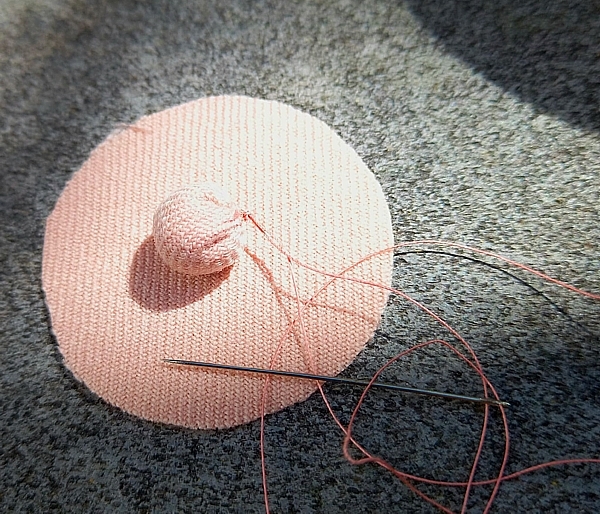
Today I sewed some of the pink, ham-coloured wool buttons and I thought it might be a nice idea to photograph a button sitting on top of the cut circle to demonstrate what size circle I start with and what size button I end up with. A fantastic idea, I thought as it's quite a thin wool, so the buttons are quite small.
Anyway, I sat for fully ten minutes looking at the photos and considering whether there was enough time in my life to deal with the hilarious fall out of putting this on social media tomorrow.
I think there is.
Ironic, isn't it, how the n!pple on the cover of my book was censored and this looks more realistic from a casual glance than the artwork ever did. Even though it absolutely is not.
Website updates
23 August 2022 08:22 pm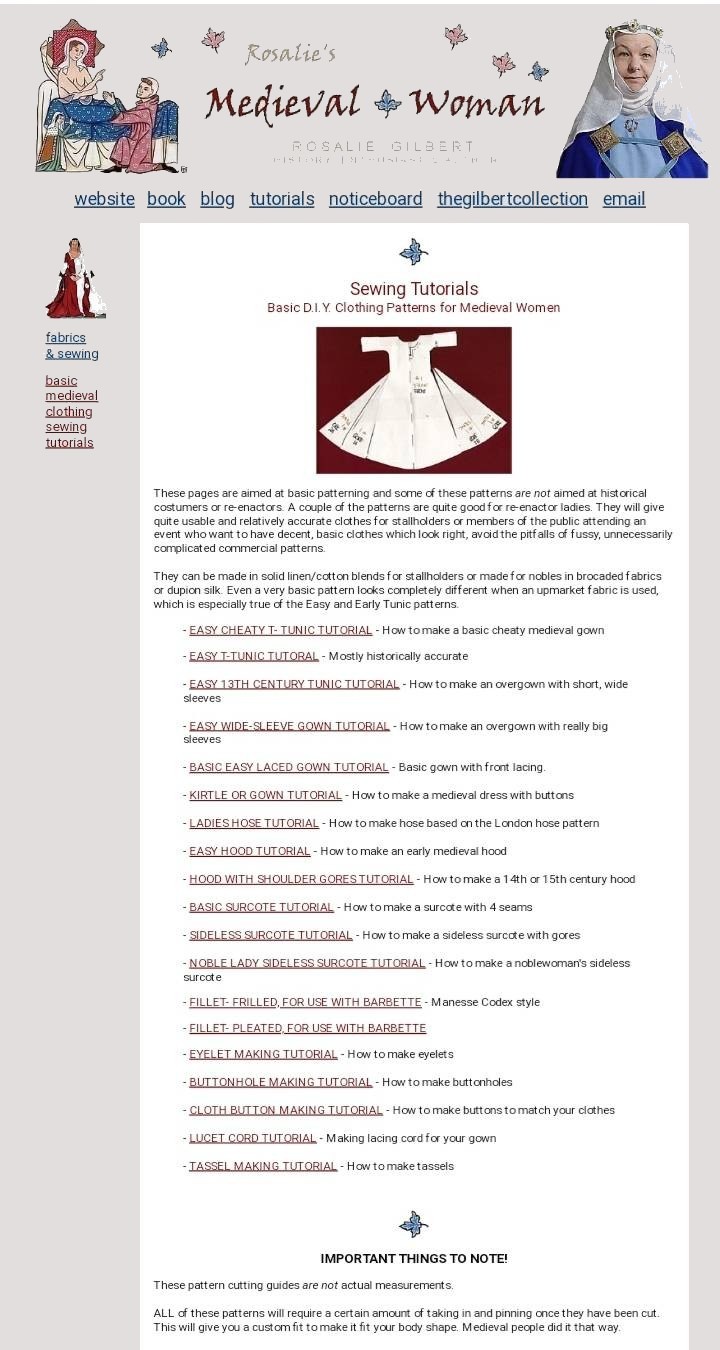
Having some fun tonight updating the tutorials page on my website. I did a share to Faceblergh earlier today and new followers are really enjoying the sewing How To links. I love it when people other than me get excited about medieval clothes.
I'm loving the new banner, which is much like the old one but the photo has been replaced.
Experimental archaeology
20 August 2022 12:24 pm
Attempting to recreate a medieval recipe can be tricky because the amounts given are often described as "some," "a little," "twice as much," and "enough." Some proportions can be gathered from this. Use twice as much rosewater and plain water, for instance. other times, one is flying blind. As part of my new medieval bath display, I hope to have a hair powder made from a medieval recipe. I'll be making it for the first time next weekend at an historical event and taking notes. At this point, I have the recipe and the ingredients, some grown and dried, others sourced from a local spice shop.
Medieval women were just as concerned with beauty products for their skin and hair as women are today. Many herbal preparations were used to cleanse, protect, lighten or dye the hair. Hair loss was also a concern which was attended to with herbal balms and tinctures. These recipes were found in manuscripts like the Tacuinum Sanitatus, which were copied and recopied.
Most recipes were herbal, but some had more exotic ingredients. The Trotula, or the texts attributed to Trotula, include On Women's Cosmetics, and include recipes for beauty including a beautiful-smelling hair powder, so that the hair remains sweetly scented. In the section about On Various Kinds of Adornments, it reads:
This is the recipe I will attempt to recreate.

This fantastic record, yes, record contains a bevvy of wonderful love songs from the medieval period. Troubadours sang and played songs of lost love, tormented love, love gone wrong and high, pure, courtly love, although it must be said that a lot of the songs were a bit less than they seemed on the surface.
For example, the song below is shown with it's original words and an English translation. It sings so sweetly, but then, at the very end, all is revealed to be not what it seemed.

I shall lead a gay and carefree life
out of love for my sweet lover whom I love
with all my heart without a base or foolish thought.
And I shall frolic and live for love-
indeed I shall- all for my pleasure and enjoyment
and for my part I wish neither to lie to him
nor to think ill of him.
And I may do so without dishonour
As every lover and his sweetheart knows
There is no harm in loving so, since it does no wrong
If there were, I'd have none of it!
In keeping with the fine and pleasant weather
I shall lead a gay and carefree life
out of love for my sweet lover whom I love
with all my heart without a base or foolish thought.
Husband, husband, shame on you for beating me so
on account of a little flirtation!
Anon. Late 14th century.
Wait, what?
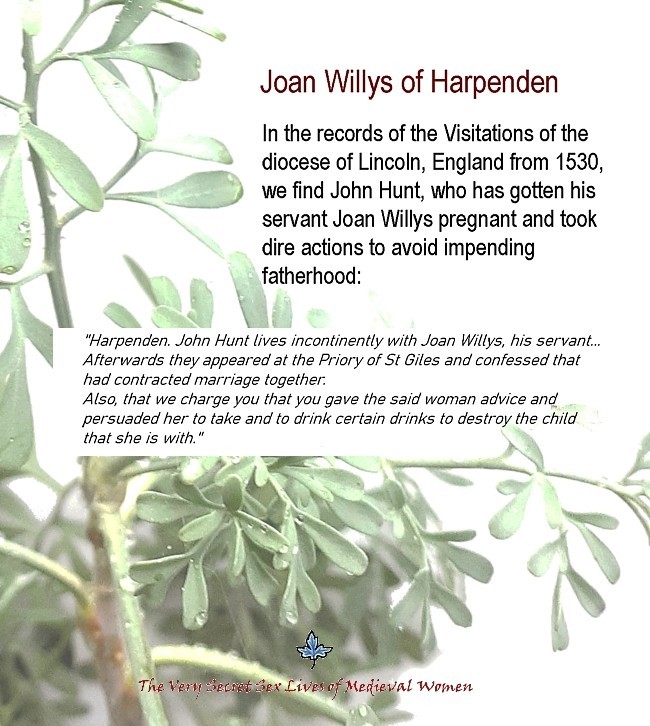
Church records are usually incomplete when it comes to the finer details of court appearances, citing only the bare bones of the cases. This is often frustrating for historical researchers, but it does allow a very small glimpse at the lives of medieval women, and very often, gives them a name.
From Lincoln in England, we find Joan Willys, who was a household servant.
She is named as part of a case in the Visitations records in Lincoln, England where her employer, John Hunt has been taken to task for improper conduct, namely living unmarried and having a sexual relationship with her as his servant.
Joan has taken certain herbs to terminate a pregnancy, but later is married to the man in question. No indication is given whether she was a willing participant in the intimate activities or whether she had no choice and was forced as his household servant. Either way, the use of the word "persuaded" when it comes to the part about ending her pregnancy is used, hinting that perhaps she wasn't entirely on board with that part.
Many medieval women had a strong church background and the fear of hell was absolutely a real thing, so deliberately ending a pregnancy may have been a decision she may not have been comfortable with.
After the Visitation, John and Joan were married, but again, there is no indication whether this was a state desired by both of them. There are a number of reasons why the marriage happened:
2. to legitimise John's child and provide an heir
3. they loved each other
Which of these is true, we will never know.
For more medieval women, the Very Secret Sex Lives of Medieval Women is available online and through all good book sellers.

From Finland With Love
19 July 2022 11:05 am
It was a wonderful Abbey Medieval Festival at the Rosalie's Medieval Woman tent! I had a very special visit from Heraldic Illuminator, Tania Crossingham who did the cover artwork for my book, The Very Secret Sex Lives of Medieval Women.
Tania is Australian born but had made a wonderful life in Finland and flew in especially for the festival and some workshops on illumination for the Abbey Museum of Art and Archaeology.
Pictured here, are myself, Tania and the original artwork she created for me.
Abbey Festival Marketplace!
16 July 2022 01:20 pm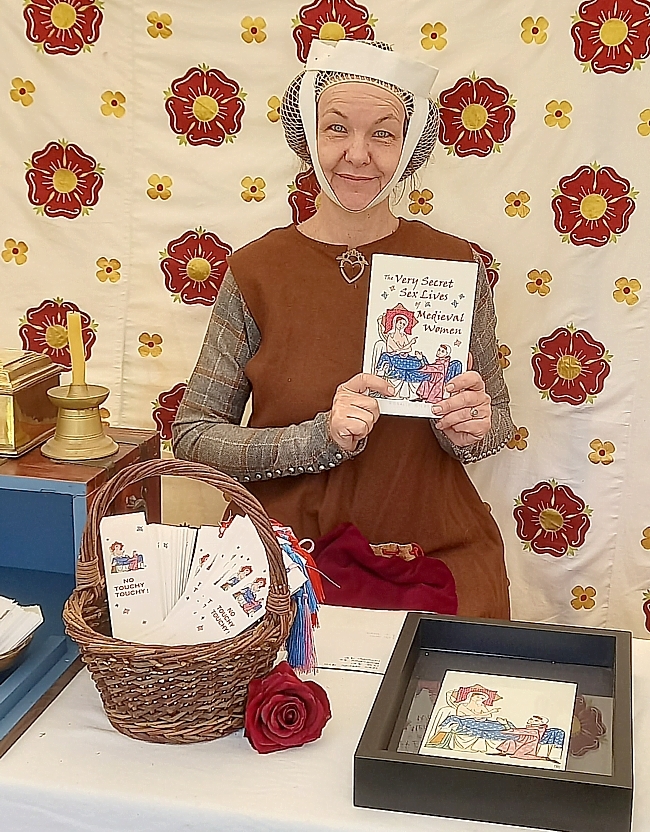
The Abbey Medieval Festival was great fun. Here's the round up:
My helper girls were all pretty fantastic. Two had not been before and were full of the wonder of seeing it all for the first time- the Jousting, the Turkish oil Wrestling, the Trebuchets, the Knights... they skipped in and out of the tent and had a great time!
Here's Alicia, doing just that!

Book sales were phenomenal for me, and I sold out almost completely on the first day and had to ask someone from Brisbane to bring more the following day. This led to a comedy of errors where my cat sitter hadn't left the keys where he should and the person couldn't get inside without a detour to pick up the keys. Not a big drama, but I was trying to conserve my phone battery, so that was annoying.
The giveaway with the secret word was a ton of fun and was won by a very excited patron.
My talks on Medieval Women's Secrets was well received with not enough seats but keen listeners sitting on the grass.
My Grandbabes visited the festival in costume! He as a dinosaur looking very dragon-y and she as a little llama. I'm to make costumes for next year and I can't tell you, I'm excited about that!
The Opening Ceremony was well received by the audience and the CEO of the Museum who hadn't seen it yet, so that was a relief. All the props I made for it were lovely and did what they needed to do.
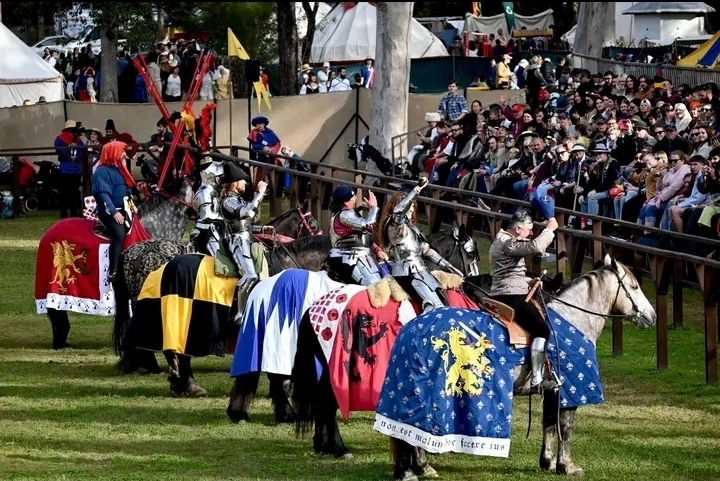
I wasn't able to see any jousting myself, but was excited that friends made it through to the final and a lady jouster won overall for the weekend. Lady Elizabeth was completely amazing! She's in red in the top photo. (both photos by James Niland)

Thankfully, it didn't rain, so my wet weather prep for the weekend wasn't needed and everything stayed nice and dry. Heavy overnight dew on the last night meant having to allow the tents to dry before pack up on Monday.
Tania who did my cover art swung past the tent and we got a few photos together. I'm looking forward to the workshop tomorrow to brush up my skills.
Shadiversity I've already talked about.
Good fun had by all. Of course, people in my tent and in camp have come down with Covid and my ex was a twit, but more about him later.
Marketplace helper, Part 2.
29 June 2022 10:54 pm
The weekend just gone was a few hours of fun while we had a bit of a photo and style session with my second stallholder assistant. She liked a few of the looks, but by far my favourite one was this.
The kirtle is machined on the inside but hand finished with all the neckline, hems and cuffs and, of course, alllll those eyelets! She's wearing one of my linen veils and wimples. I really enjoy taking the photos so the ladies can see for themselves what looks great so they can rock them with confidence. She liked the one without the wimple, but it really is a great look for her, and perhaps when she sees the rest of us with ours, she'll feel like joining us.
No real issue if she doesn't, but it's going to be cold, so a snuggly hood and surcote might be the mode instead!
Dressing up!
23 June 2022 07:04 pmThis afternoon I had my lovely friend come over to try on some outfits for the upcoming Abbey Medieval Festival. She's still suffering with post-Covid laryngitis, but never-the-less we had fun trying on a few outfits and experimenting with veils and getting different looks. Although she's helping out in the marketplace with me, we tried some working class looks and a couple of slightly more well-to-do options.
This one is my favourite! A few hours well spent with good results!


